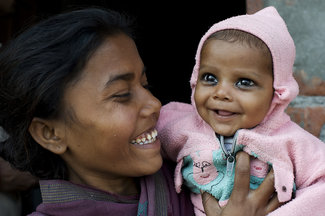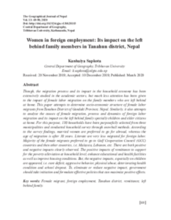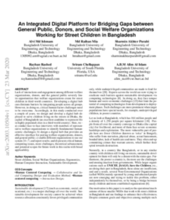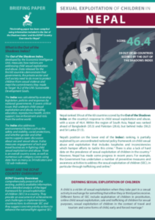

Displaying 261 - 270 of 735
This special issue of the Institutionalised Children Explorations and Beyond journal, guest-edited by Delia Pop, Tessa Boudrie and Mark Riley of Hope and Homes for Children, focuses on deinstitutionalization in South Asia.
This paper attempts to determine socio-economic structure of female labor migrants from Tanahun District of Gandaki Province, Nepal. Similarly, it also attempts to analyze the causes of female migration, process and dynamics of foreign labor migration and its impact on the left behind family specially children and elder citizens at home.
In this study conducted over a couple of years, the authors design and develop a digital hub deployed to serve children living on the streets in Dhaka, the capital of Bangladesh.
The purpose of this study was to investigate the emotional and behavioral problems of children living in child care institutions (CCIs) in Kandy District, Sri Lanka, and to explore associated factors.
The 1st Care Leavers Convention being held from March 13 – 14, 2020 in India, is providing an opportunity for practioners, NGOs, professionals, researchers, students and organisations to showcase their research work, promising practices, good models and insights with Care Leavers.
"Orphanage tourism turns children into cash-generating commodities subject to the usual economic laws of supply and demand," says this article from New Europe.
This briefing paper has been compiled using information included in the Out of the Shadows Index - which measures a country’s response to child sexual exploitation and abuse - and the ECPAT Country Overview for Nepal. The brief highlights the risk of sexual exploitation resulting from voluntourism practices, including volunteering in or visiting orphanages.
The objective of this study is to understand the use of parental-group intervention for helping parents understand the problems of their children and to develop skills to deal with those problems.
The present research study was aimed at exploring the Psychological Capital Development in Street Children through Education at Child Protection and Welfare Bureau, Lahore.
This paper is a condensed version of a study entitled “Beyond 18: Leaving Child Care Institutions - Supporting Youth Leaving Care: A Study of Aftercare Practices in Five States of India”, which found that upon turning 18, youth transitioning out of child care institutions to independent life in India experience many challenges, such as securing housing and identity documents; accessing education, skill development, and employment opportunities; and garnering psychosocial support.




